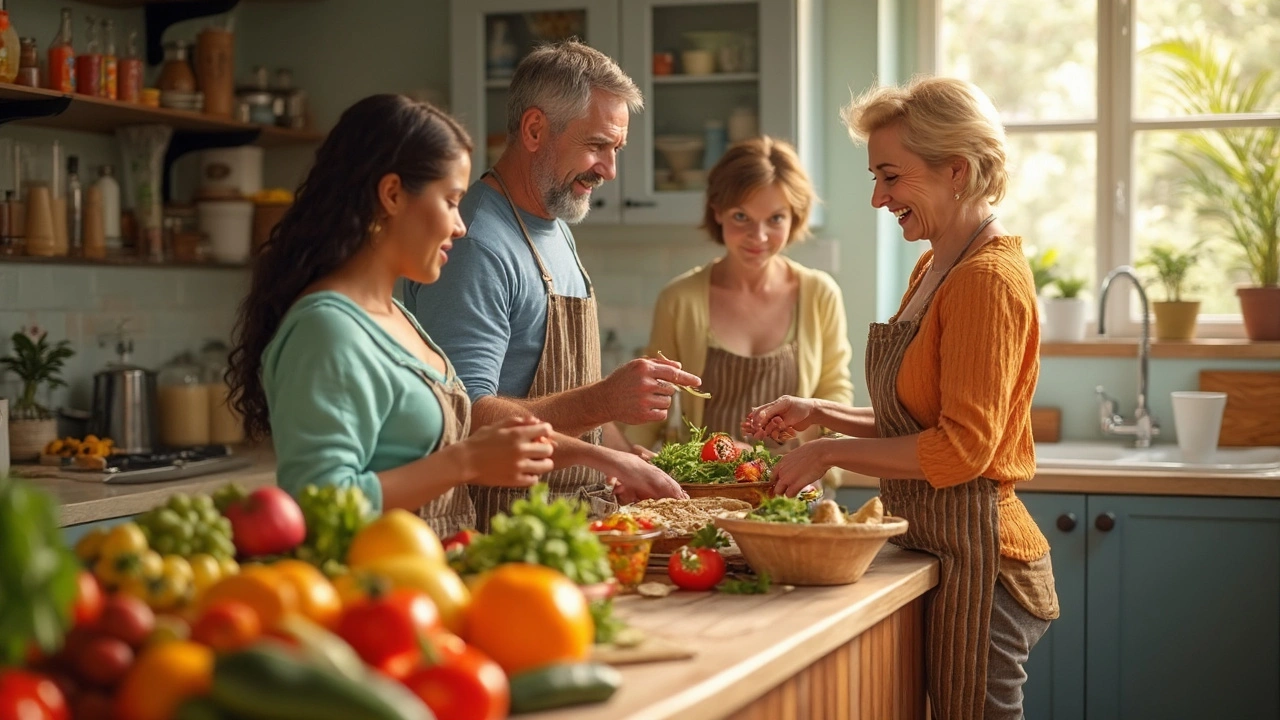
Waking up at three in the morning, clutching your lower abdomen, desperate for the spasms to stop—nobody chooses that kind of misery. People living with urinary tract spasms often feel ambushed: everything is fine, and then Bam! There’s that sharp, unpredictable pain again. If you’ve ever googled “How do I stop urinary spasms now?” you’re not alone. What a lot of doctors don’t mention (or maybe just don’t have time for) is how much your daily diet messes with your bladder. Weird, right? But the science finally backs up that little voice in your head that insists, “Something I ate made this worse!”
Why Diet Matters in Urinary Tract Spasms
So, let’s cut to the chase. Your diet isn’t just about calories and vitamins—it influences some of the strangest things, like how your bladder muscle contracts or relaxes. Urinary tract spasms happen when those bladder or urinary tract muscles contract in a way that’s painful and sometimes urgent, even when you don’t really need to pee. This isn’t just a small issue; it can severely impact daily activities and sleep. For many people, it starts after a urinary tract infection (UTI), surgery, or as a part of chronic bladder issues like interstitial cystitis or overactive bladder syndrome.
What rains on your parade the most? Irritation. Many common foods and drinks act like little troublemakers, irritating the lining of your bladder and causing those muscles to twitch and spasm. Acidic foods are some of the worst offenders—think orange juice, tomatoes, and even your daily coffee. According to a review in the journal Current Bladder Dysfunction Reports (2024), dietary triggers can vary a lot from person to person, but certain patterns are seen over and over.
Some people find relief once they start keeping a “bladder diary.” This isn’t just journaling for self-care; it’s a log of everything you eat and drink, cross-referenced with your symptom flare-ups. After a week or two, patterns jump out: maybe spicy foods or artificial sweeteners are the culprits, or perhaps a sneaky guilty pleasure like soda or chocolate. Once you know your triggers, you can actively reduce spasms just by changing what’s on your plate or in your cup.
And it’s not just what you eat; when and how you eat matters. Eating several smaller meals throughout the day, instead of two gigantic ones, puts less stress on your digestive and urinary systems. Pair that with proper hydration—water is your friend—and you set yourself up for less irritation. Not too little water (urine gets too concentrated and burns), but not an overload, either (which makes your bladder overactive).
One surprising fact: there’s a two-way street between your bladder and your gut. Researchers in Sweden found that people with irritable bowel syndrome are almost twice as likely to have overactive bladder or urinary spasms. That means foods that upset your gut can set off the bladder, too—a sneaky connection most people overlook.
| Food/Drink | Effect on Bladder | Common Reported Trigger (%) |
|---|---|---|
| Coffee/Caffeinated drinks | Irritates bladder lining, increases urgency | 70% |
| Spicy foods | Aggravates symptoms in sensitive people | 62% |
| Artificial sweeteners | Believed to promote spasms and irritation | 55% |
| Citrus fruits/juices | Highly acidic, worsens bladder pain | 48% |
| Alcohol | Diuretic, increases urine volume and spasms | 63% |
Ever felt your symptoms get worse after happy hour or cheat day? You’re not imagining things. Like Dr. Elizabeth Kavaler, urologist at Lenox Hill Hospital, once commented:
"Dietary triggers are incredibly individual, but almost every person with bladder discomfort benefits from easing back on caffeine and alcohol."
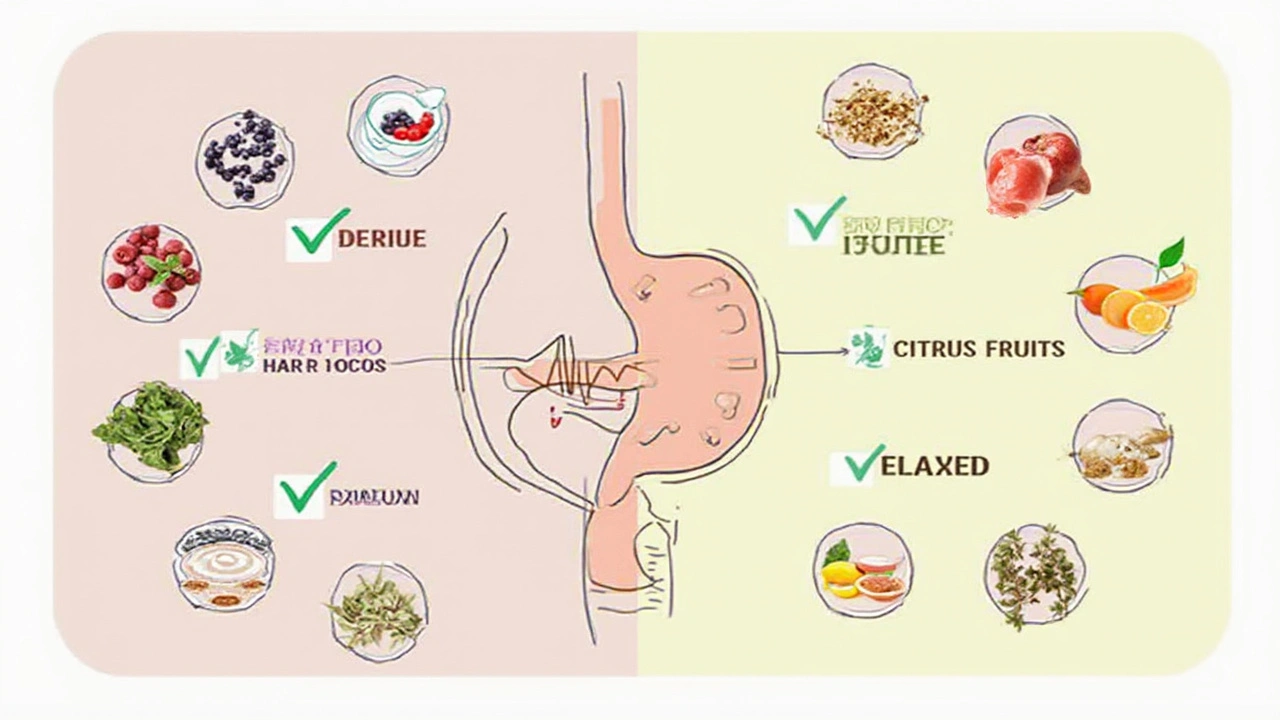
Foods and Nutrients That May Help With Spasms
Now, let’s switch gears. You know what to cut—or at least what to experiment with cutting. But what can you actually eat to make your bladder happy? Turns out, there are plenty of food choices that can reduce irritation and even offer some soothing benefits.
First up: low-acid fruits and veggies. Blueberries, pears, bananas, and watermelon don’t tend to set off spasms for most people. Greens are your friends too—spinach, kale, cucumbers, and carrots are mild on the system, full of vitamins, and don’t spike acidity. Grains like brown rice, oats, and barley provide filling, bladder-safe carbs without much fuss.
When it comes to protein, stick with lean choices. Fish, chicken, and eggs typically don’t trouble the bladder, unlike processed meats that are high in nitrates and salt. Plant proteins—like lentils and chickpeas—are also less likely to cause flares, assuming they don’t trigger IBS for you. Dairy can be hit or miss, but plain Greek yogurt and hard cheeses are usually safer bets.
Let’s dive into anti-inflammatory foods for a second. Why are they important? Urinary tract spasms often come with inflammation of the lining. Omega-3 fatty acids, found in fish like salmon and seeds like flax or chia, have solid research behind them for their anti-inflammatory role. Some folks add a turmeric supplement to their routine, since curcumin (found in turmeric) can also calm tricky inflammation.
Hydration is its own category. Water is number one, but if you want variety, herbal teas like chamomile or ginger tend not to annoy the bladder. Go easy with cranberry juice, though—a small glass might help prevent UTI, but too much acidity can make spasms worse for certain people. It's all about finding that sweet spot for your own body.
Ever wondered about probiotics? Recent research published in the World Journal of Urology (2023) found that women with chronic bladder symptoms, including spasms, reported better comfort and fewer recurrences when they regularly used a probiotic supplement. Fermented foods like kefir, sauerkraut, miso, and plain yogurt can provide these gut-friendly bacteria. Improving your gut health might help break the bladder-gut cycle we talked about earlier.
Here’s a practical trick: if a new food is making you uneasy, try a "two-bite test." Eat a small amount, then see how your body feels two or three hours later. Your bladder might thank you—or you’ll save yourself a night of discomfort.
Still, food tolerances are personal. If you love tomatoes but hate the pain, it might be worth only eating them with other bland foods, which can sometimes soften the acid hit. And if you experiment, jot it all down. That “bladder diary” is your best backup if you need to talk adjustments with your doctor or nutritionist.
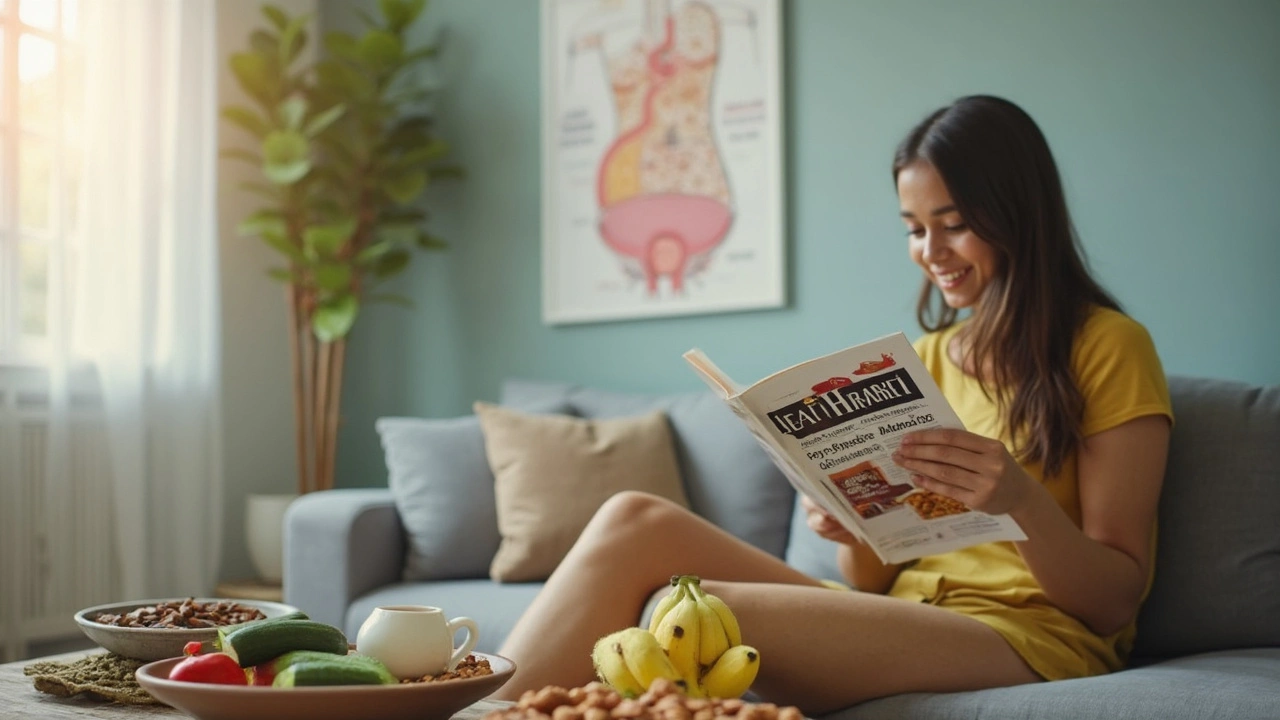
Practical Diet Tips for Managing Spasms
So, how do you make all this information work for you? First, don’t overhaul your diet overnight—that’s a ticket to frustration. Try adjusting one or two foods at a time to see what changes. Here's a battle-tested tip: focus more on what helps than on denying yourself. Building a menu of bladder-friendly favorites gives you choices when cravings strike or when you’re out at a restaurant.
- Stick with water or herbal tea; limit coffee, cola, and energy drinks—these are notorious spasm triggers.
- Swap citrus for less acidic fruit like pears or blueberries in your breakfast smoothie.
- Choose plain grains like oats or rice over spicy or processed carbs.
- Try grilled chicken or fish instead of processed deli meats.
- Check packaged foods for artificial sweeteners like aspartame or saccharin, as these often sneak in where you least expect.
- If you eat dairy, opt for unsweetened yogurt or hard cheese rather than milk or cream-based treats.
- Plan snacks of cut-up veggies and hummus, or unsalted nuts and seeds.
Struggled with taking supplements or drinking cranberry juice for prevention? Don't forget: too much of a good thing backfires. Large amounts of vitamin C can acidify urine and trigger spasms—so stick to natural sources, and check with your provider about dosing. Ditto for drinks labeled as "detox" or "cleanse." These often contain diuretics or acids that might upset a sensitive bladder.
Meal timing plays a role, too. Eating heavier meals earlier in the day can sometimes reduce nighttime symptoms. Try not to eat two hours before bedtime, since a full bladder and digestion working overtime often spell disaster after dark.
For those with recurring issues or a diagnosis of interstitial cystitis, it might be worth getting a dietary consult. Many insurance plans now cover nutrition counseling for chronic pelvic pain and bladder issues.
If you want to share what works with your own healthcare team, some health apps let you track symptoms and triggers in real time, which can lead to better treatment tweaks. Even better: several pharmacies carry at-home pH urine tests, giving you instant feedback about acidity after meals.
Here’s a quick myth-buster: drinking less water doesn’t stop the spasms. In fact, concentrating your urine usually sets off more symptoms. Sip steadily throughout the day, aiming for at least six to eight cups if your doctor agrees that's good for you.
And don’t ignore supplements entirely. Magnesium has shown promise in reducing bladder muscle overactivity for some. Small-scale studies suggest up to 25% of participants noticed fewer spasms after 2-4 weeks of daily magnesium citrate—but as always, talk this through with your provider.
Bladder health might not be glamorous, but unlocking your own food triggers and comfort foods can leave you confident and—in the middle of the night—gratefully not in pain.

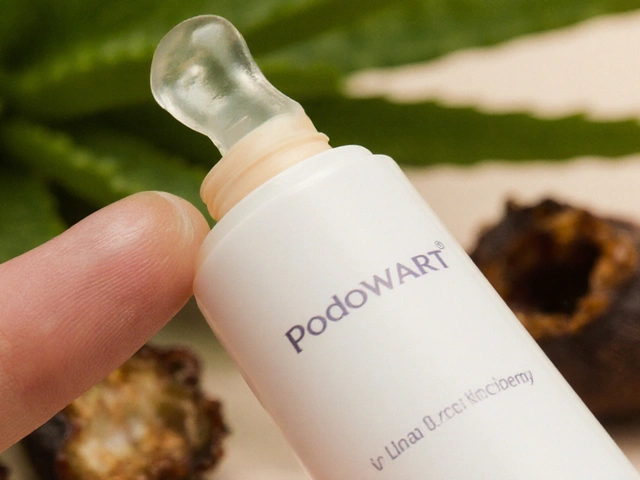
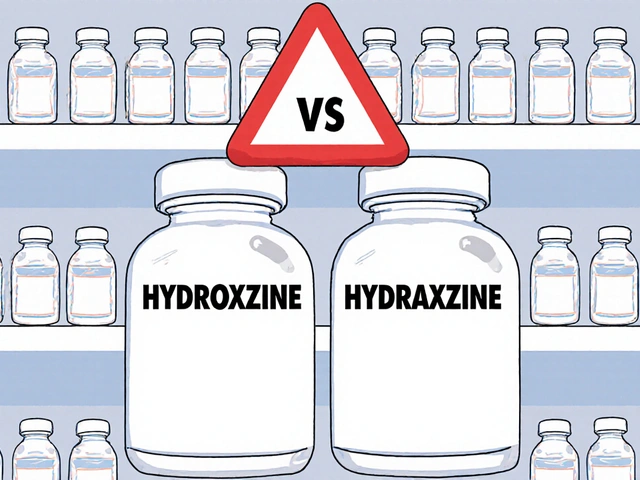

8 Comments
i used to think my bladder was just being dramatic until i started tracking what i ate. coffee and diet soda? total disaster. switched to herbal tea and water and holy crap, i actually slept through the night for the first time in years. not magic, just science.
Stop blaming food. This is just weak people making excuses. Back in my day, we drank coffee, ate spicy tacos, and never complained. If your bladder can't handle normal life, maybe you need to toughen up instead of playing diet detective.
MaKayla is right, but also... i get it. I cried in the bathroom at 3am last week because my bladder felt like it was on fire after one slice of pizza. I didn't even like the pizza. But it was there. And now i'm terrified of everything. Even my own water bottle. I just want to eat a burrito without crying.
The bladder-gut axis is one of the most underappreciated physiological connections in modern medicine. The vagus nerve doesn't just regulate heart rate and digestion-it modulates detrusor muscle tone and pelvic floor reactivity. When you eliminate inflammatory triggers like artificial sweeteners and caffeine, you're not just reducing irritation-you're resetting autonomic signaling pathways that have been dysregulated for years. The fact that probiotics show measurable improvement in symptom frequency isn't anecdotal-it's neuroimmunological. This isn't a diet hack. It's neurobiology with a side of hummus.
While the article presents a plausible correlation between dietary intake and urinary tract spasms, it lacks sufficient statistical control for confounding variables such as comorbid psychiatric conditions, medication use, and hydration variability. The cited percentages from the journal review are not adjusted for population demographics, and the 'bladder diary' methodology introduces significant recall bias. Without randomized controlled trials or double-blind dietary interventions, this remains speculative at best.
Hey everyone-just want to say you’re not alone. I’ve been where you are. I started with one change: swapping my morning coffee for warm lemon water (just a splash, not a whole lemon). It took two weeks, but the 3am panic attacks stopped. I didn’t fix everything overnight. I just picked one thing. And now I have a list of safe foods that feel like a hug for my bladder. You don’t need to be perfect. Just start somewhere.
blueberries good. coffee bad. water good. i learned this the hard way. now i just eat simple stuff and chill.
If you can’t handle tomatoes, you don’t deserve to eat food. This is the new weakness culture. Just endure it.